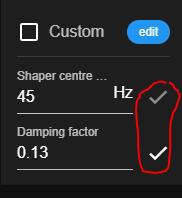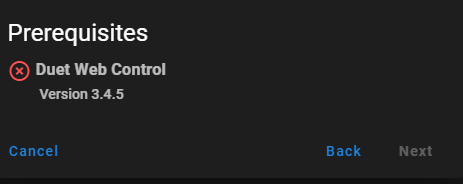New Input Shaping plugin v3.4.1-b1
-
@ratrig0331 thanks for your M122 report. I've seen this issue once before. I am fairly sure it is caused by problems with the accelerometer wiring that result in communication issues between the accelerometer and the Duet.
-
I noticed just today, that this plugin existed. Must have been two days before release or so that I wrote a macro myself for doing this. (see below)
Turns out I basically hit bullseye by accident with my shaper settings after running my macro and now comparing the results with the plugin, just because I did not know that MZV would dampen two frequency amplitudes and the second one did luckily coincide perfectly with the amplitude of my x-axis
But the user Interface of the plugin is very good especially the merged frequency analyses of multiple axis and the damping curves preview for the shapers.
Only thing I would like to add though are inputs for the acceleration and speed at which the accelerometer data is collected.
Just a little QOL thing with e.g. a tickbox for "use maximum speeds and accelerations from current config" and if you untick it, you can enter your own values so that they are set before starting the sequence automatically instead of the user having to enter them manually before going to the plugin.
Oh and returning the printhead back to the center position after the last move would not trigger my OCD
Also a little sidenote if a dev reads this:
We now have Height Map in the Control tab
The Accelerometer Viewer in Machine Specific under the Settings tab
and the Input Shaping Plugin under the Plugins tab
One could also debate about the G-Code Viewer (I personally like it under the Job tab) but at least the above three (and maybe even the Object Model browser) are pretty similar and thus should be under the same tab IMO.
Please feel free to discuss my opinion though.the macro if anyone is interested:
var origXAccel = move.axes[0].acceleration var origYAccel = move.axes[1].acceleration var feedrate = move.axes[0].speed if exists(param.F) set var.feedrate = {param.F} echo "speed for accelerometer data collection:", {var.feedrate/60}, "mm/s" else echo "param.F not provided, instead maximum speed (X) is used for accelerometer data collection:", {var.feedrate/60}, "mm/s" G28 G1 X{move.axes[0].max/2} Y{move.axes[1].max/2} F9000 if exists(param.A) echo "setting X and Y acceleration to", {param.A}, "mm/s^2" M201 X{param.A} Y{param.A} M201 else echo "param.A not provided, using current accelerations X:", {var.origXAccel}, "mm/s^2, Y:", {var.origXAccel}, "mm/s^2" echo "collecting acceleration data for X-Axis" G91 ; relative positioning G1 X-50 F9000 G4 S2 M956 P21.0 S1000 A1 F"inputShapingX.csv" G1 X100 F{var.feedrate} G4 S2 echo "collecting acceleration data for Y-Axis" G1 X-50 Y-50 F9000 G4 S2 M956 P21.0 S1000 A1 F"inputShapingY.csv" G1 Y100 F{var.feedrate} G4 S2 G1 Y-50 F9000 G90 ; absolute positioning if exists(param.A) echo "reverting changes in acceleration" M201 X{var.origXAccel} Y{var.origYAccel} M201 -
@schild0r said in New Input Shaping plugin v3.4.0-b1:
We now have Height Map in the Control tab
The Accelerometer Viewer in Machine Specific under the Settings tab
and the Input Shaping Plugin under the Plugins tab
One could also debate about the G-Code Viewer (I personally like it under the Job tab) but at least the above three (and maybe even the Object Model browser) are pretty similar and thus should be under the same tab IMO.this is a good point. The different features are implemented at different levels of "core" from build in from a long time ago to a new and experimental plugin, so the UI location is more based on that than on a logical place for them to be from a user use perspective. We will think about how this could work going forward, especailly as we want to encourage more plugins to the UI.
-
@dc42
It did seem to be my connections I soldered the wires directly to the accelerometer chip with a pig tail plug vs the screw post terminals I had soldered to the chip and everything seems fine now, I still have no clue what to do with the data collected yet but I’m here to learn -
@ratrig0331 I'm glad it's working now.
-
 undefined chrishamm referenced this topic
undefined chrishamm referenced this topic
-
Version 3.4.1 is now available to fix the record dialog for users who have tools with gaps defined (e.g. T1 but no T0).
In addition, the shaper prediction now supports custom shapers - just make sure to be on 3.4.1 before you attempt to use this feature. When you enable it, the shaper parameters are copied from the current input shaper and by using the arrow keys in the edit dialog inputs, you can immediately get an estimate of the resulting damping curve. There is no further documentation about this feature yet and most users should not need it either. I meant to release v3.4.0 with this feature enabled but it still required a fix from v3.4.1.
-
Is there an easy to follow wiring diagram for the LIS3DH and the Duet2Wifi.
I find matching pins tricky and confusing that are listed on
https://docs.duet3d.com/en/User_manual/Tuning/Input_shaping_pluginneed something for my simpler brain lol
-
@chrishamm Installed it this evening on my Predator, it's fairly easy to use and compare the different graphs.
I would suggest 2 things:
1- Add the damping factor used in the records

I started to "play" with the damping factor to see the impact on the graphs but I lost track of the value used at one point.2- It took me a little bit of time to realize that I needed to click on the check-mark for set the Shaper Center Frequency and Damping factor.

I think I was "deceived" because changing the Shaper Center value immediately moves the blue bar in the graph so I wrongly assumed it would use it when doing a new record.
I must admit that I didn't paid much attention to the summary in the first modal box.This has been mentioned before, I don't know if it has been fixed in this beta but I'm getting this message as well

This printer has a Duet 2 Wifi and a Smart Effector v3 -
Wish there was a video tutorial on the input shaping process with RRF and this plugin. So much content using klipper, yet to find one with duet
-
@adamfilip by and large, the procedure is the same, with the distinction that the tooling around using the accelerometer on Klipper is (naturally) a bit more mature. Not many people do RRF videos though ... but there is not much to it.
- on belt driven axes, multiple peaks on one axis indicate something is loose and is adding additional vibrations. Trying to find those and fixing them is a valuable venture anyways.
- on kinematics combining drives such CoreXY it is desirable that the measured curves match, since it indicates similar tension. Do not confuse this with finding the right tension though. That is dependent on belt lengths and your motion system.
- On Cartesian systems, individual axes may have different curves.
- On RepRapFirmware -- other than klipper -- you can only set one input shaping algorithm, frequency, and damping setting. In practice, the damping factor is enough to cover the usual span of different frequencies on different axes.
- The InputShaping plugin visualizes the measured vibration per axis, but also a recommended frequency, and you can tell it to show the effect on the frequency graph by a given algorithm and damping factor. Ideally, the damping factor is as low as possible to reduce the effect of input shaping on speeds/accelerations that aren't inducing ringing.
- It's likely useful to retune PA after tuning input shaping since there is some interaction between InputShaping and PA.
-
@oliof As I had posted in another thread, I measured my frequencies and applied a shaper and measured again and it looked good. (I haven't posted my results, yet.) But when I printed a test part, the ringing was noticeably worse.
What would this be an indication of? Damping factor too high?
-
@tfjield very hard to say without seeing the curves and the before/after. It might be possible that you saw something on the graph that was just loose and overshadowed the actual measurement.
If all else fails, you can print the klipper ringing tower to validate what you measured.
-
@dc42 said in New Input Shaping plugin v3.4.1-b1:
@ratrig0331 thanks for your M122 report. I've seen this issue once before. I am fairly sure it is caused by problems with the accelerometer wiring that result in communication issues between the accelerometer and the Duet.
I still use the integrated input shaper that is integrated in RRF 3.4.2rc1 (2022-07-06), until I read about the input shaping plugin 3.4.1-b1 today and installed it right away.
After about 30 minutes of use, I had several disconnections with the new plug-in, which I did not have with the previous input shaping plug-in from RRF 3.4.2rc1 (2022-07-06), so I rule out problems with the cable.
I then turned my printer off and on again at the power switch.
After that everything was OK and I haven't had these disconnections anymore.Just for info, maybe it will help !?
Google Translate
----- Original Text -----Ich nutze bis heute den integrierten Input Shaper der in RRF 3.4.2rc1 (2022-07-06) integriert ist, bis ich heute von dem Input Shaping PlugIn 3.4.1-b1 gelesen hatte und es gleich installierte.
Ich hatte mit dem neuen PlugIn nach etwa 30 Minuten Nutzungszeit mehrere Verbindungsabbrüche, die ich mit dem vorherigen Input Shaping PlugIn aus RRF 3.4.2rc1 (2022-07-06) nicht hatte, daher schließe ich Probleme mit dem Kabel aus.
Ich machte dann meinen Drucker einmal Aus und wieder An, am Netzschalter.
Danach war alles OK und diese Verbindungsabbrüche hatte ich bis jetzt nicht mehr.Das nur zur Info, vielleicht hilft es weiter !?
-
@chrishamm @dc42
When will be a release for 3.5:-) -
-
@PCR great can you share the release notes?
-
-
@Adamfilip you can't install 3.5.0-b1 on 3.4.5, only on 3.5b1
-
@Adamfilip Use this one for 3.4.5: https://github.com/Duet3D/InputShapingPlugin/releases/tag/v3.4.1-b1

